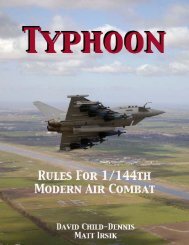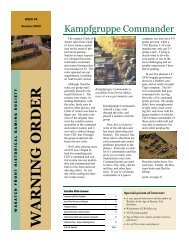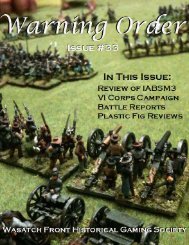Warning Order - Wasatch Front Historical Gaming Society
Warning Order - Wasatch Front Historical Gaming Society
Warning Order - Wasatch Front Historical Gaming Society
Create successful ePaper yourself
Turn your PDF publications into a flip-book with our unique Google optimized e-Paper software.
BattlegroundGame Review by Jeff GeislerBattleground is non-collectible (howrefreshing) card game that amounts to aset of simple but subtleminiature rules you can playwith cards.There are currently three factions(men, orcs, and undead) with two decksfor each, a basic and advanced set. Thefactions are fantasy, but historical diehardscould play with just the Men ofHawkshold deck. The rules come in thebox but are also available online(www.yourmovegames.com) – unfortunately,no bigger than the printed set. Allyou need to play is in the basic set. Infact, you can try the combat mechanicsout with the starter rules of about 650words.The deck consists of unit cards, commandcards, and the player chart cards,such as special rules for the army and thesample army lists. The unitcards are overhead depictionsof groups of figures thatlooks like a base of, say, 15mm fantasy figures fromabove. The back has a drawingof an individual from theunit, and any special rules.These have the unnaturalsheen of computer-generatedart for a video game, and notvery appealing art at that. While functional,they will not quicken the heartbeatof any dyed-in-the-wool miniature paintersI know.The back edge of the card has a unitroster. This has the stats for the unit, suchas attack and defense. There is no particulardistinction in weapons or armor - betterarmor would just have a higher defensenumber, for example. There arecolored boxes to represent the stayingpower of the unit, both in number of hitsand in morale. Units with more membersmight have more boxes (more hits). Unitstake morale checks when they have usedup their good morale boxes. So elite unitshave fewer total boxes, but more are goodmorale. This is a nifty method to representthe brittleness of such units.Command cards are special abilities,customized for each army. They mostlyaffect combat, making your hits moretelling or adding to a unit’s defense.Aside from the fact that armies are madeup of standard fantasy types, this is theclosest thing to magic that the gamehas to offer. You want to preservethem for critical combats or particularlytough opposing units. At thestart of the turn, you have the option tospend command points to buy more. Iwill have more to say about this in a moment.There is a nicely selected, minimal setof situational modifiers summarized onthe player-aid card. Starter armies areabout 1500 points and have differentthemes, emphasizing cavalry or shooting,for instance. Units are in the 200-400point range, so these armies have about10 maneuver elements in them. Unit costsare calculated to single digits; if the gameproves to be balanced, someone did a lotof play testing to refine point values soexactly.Set up and scenarios, at least in thebasic game, are very simple. (Terraineffects are in the advanced game rules.)At start, you give your units one of threeorders: Hold, Range, or Close. Hold isobvious. Range, which can only be givento missile armed troops, means move intorange and start firing. Close is the mostinteresting order. It means “Move at fastestspeed to close with the nearest enemy.”You must take a bit of care in issuingthis order and its relationship to deployment.Not all units move at the samespeed. If you order Close all along theline, some units may get ahead of others.Once within charge range of the enemy,they must engage. This may open flankingopportunities for your opponent. Onthe other hand, you can use maneuver toforce charges and dislocate the enemy inturn.The move to Close rules hinge on whois the “nearest enemy.” The rules describingthis are not the best – usually, it is“nearest enemy to the front.” My opponentand I interpreted the language about“farthest corner away from the enemy” tobe a way to express how far the unitwould have to move to engage, that is,the wheeling distance if attacking on aflank or the move ahead distance to attackto the front. This part of the rules isboth important and subtle; more exampleswould have been helpful.You have an opportunity to change theorders of a unit at the start of each turn.This costs a command point. You get onecommand point for every 500 points oftroops, so they are scarce. You also wantto use them to draw command cards. Youcan also take command of any individualunit for one turn per command point.They are also used for rallies. This suggestthat the object of the game is to dislocatethe enemy and cost him commandpoints, while your better planning letsthem accrue in your favor, giving youmore command cards helpful for swayingcombat to your advantage.The game is IGO-UGO, starting withthe command phase, then movement.Combat is simultaneous, so you have tokeep track of the turn in which casualtieswere inflicted. This is messy, but superiorto games (unmentioned, or is it unmentionable?)in which the charging troopsalways get first blow, and obliterate thefront rank of someone’s poor little goblins,so they don’t even get a chance tofight back – not that I mind really, (sniff,sniff).The basic combat system dices offagainst the difference between comparablestats. (Cont. on p18)ISSUE #14Page 15







